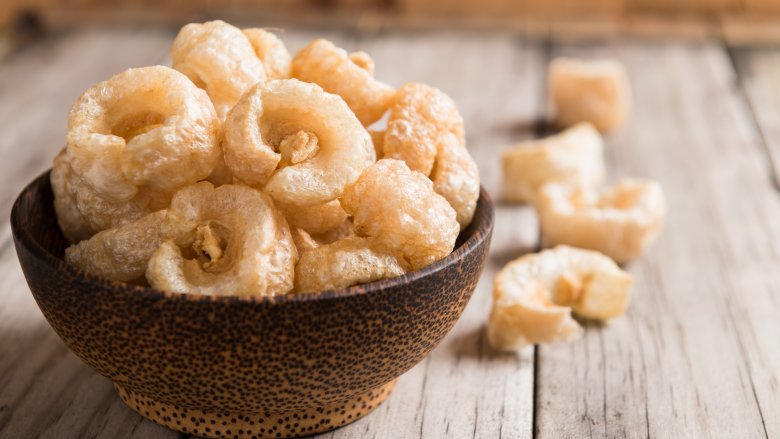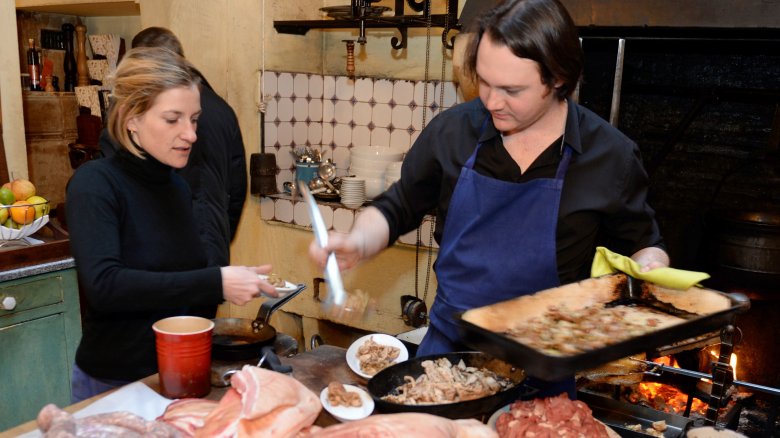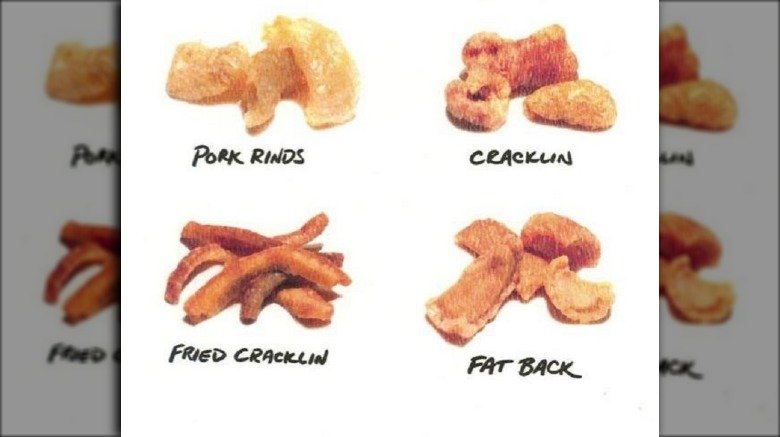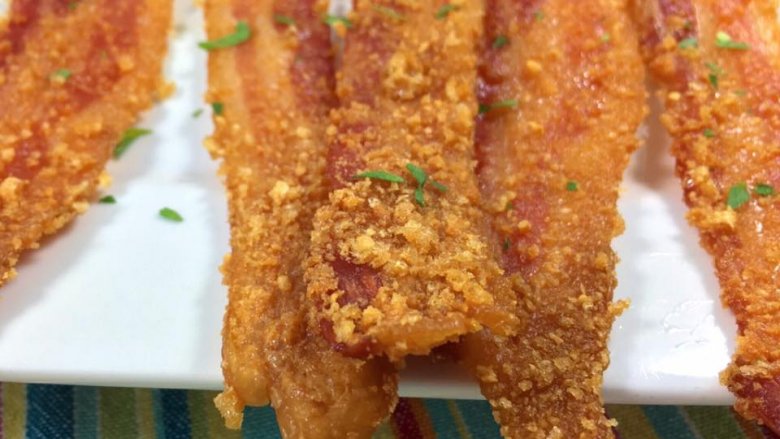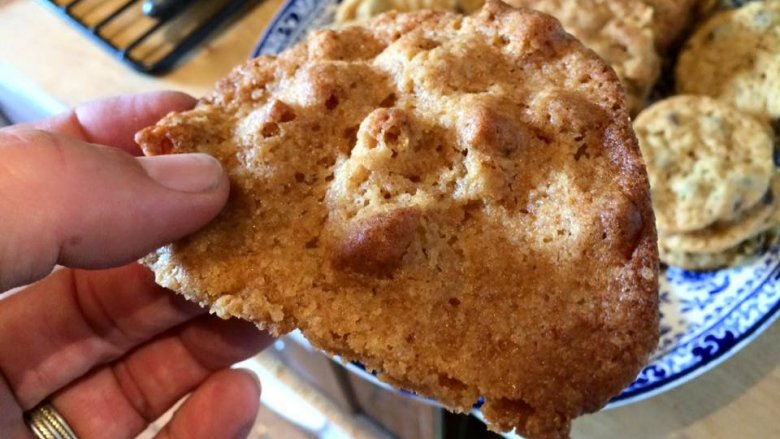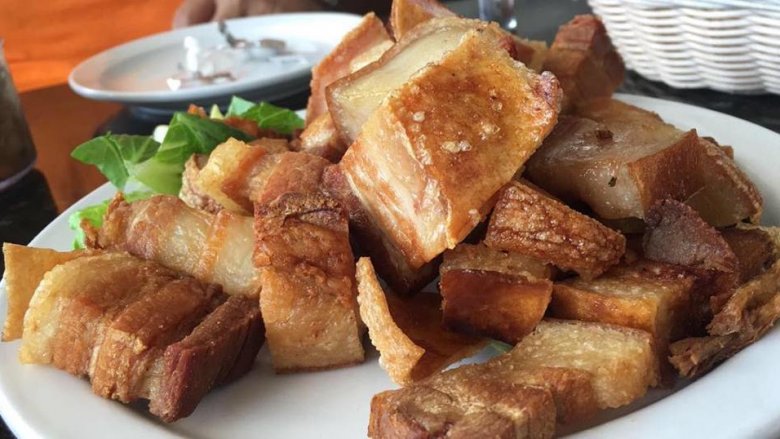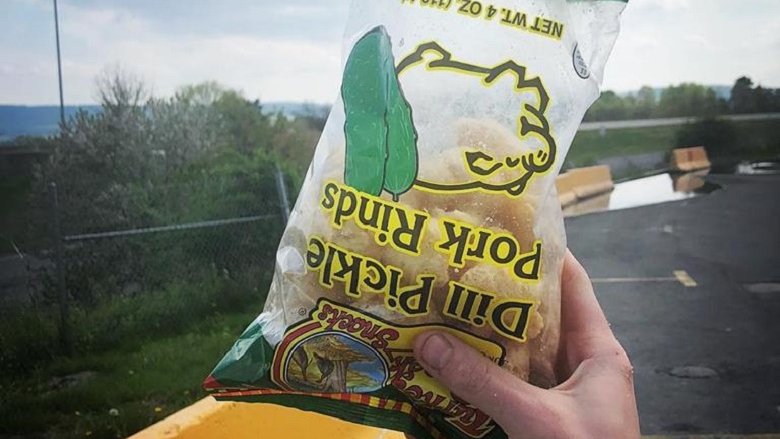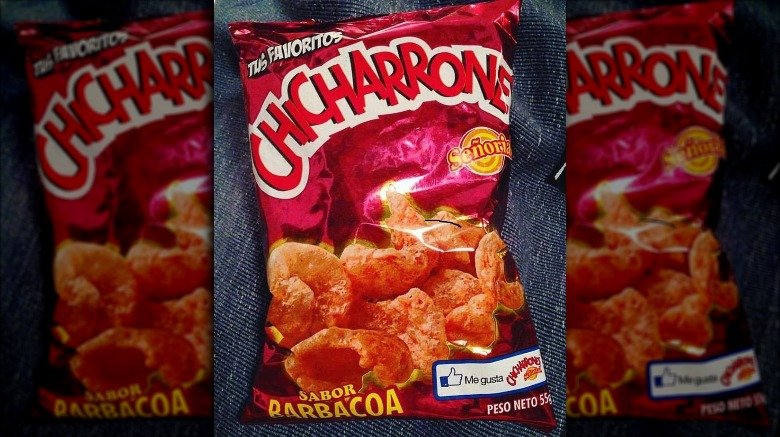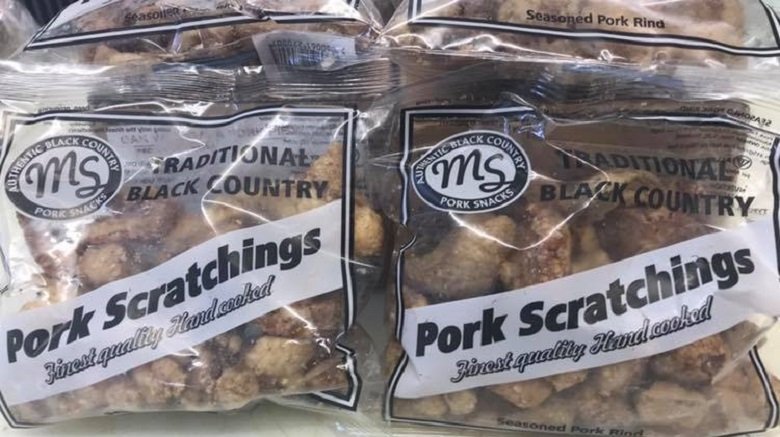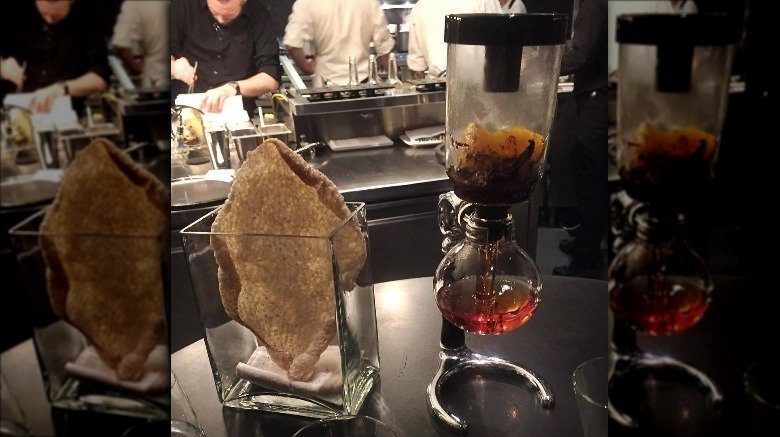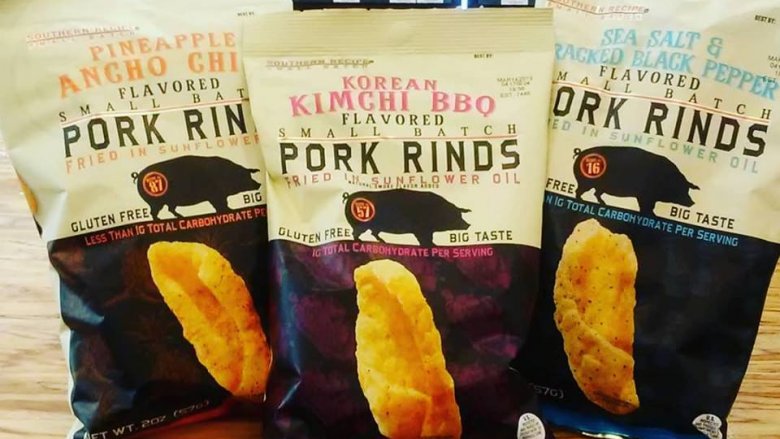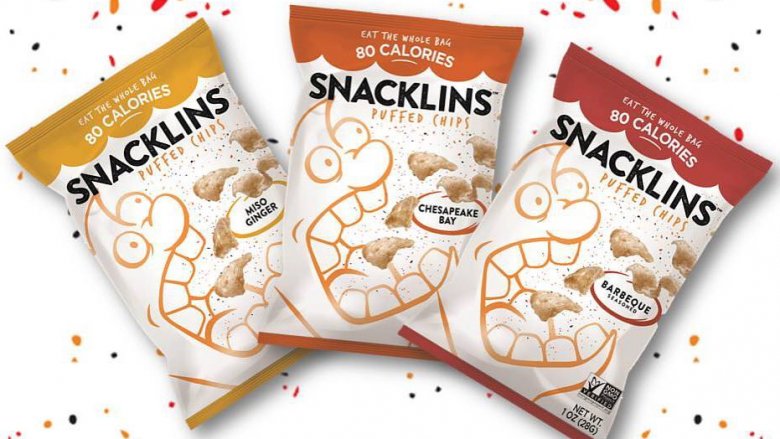The Truth About Pork Rinds
Pork rinds are undergoing somewhat of a renaissance these days. They were once seen as the epitome of southern poverty cuisine, something you'd pick up at a gas station along with an RC cola and a pack of Red Man. Once the low-carb crowd discovered that pork rinds were not only diet-friendly but also quite tasty, this once-humble product started to gain some mainstream snack cred. And as soon as chefs and snack makers realized that pork rinds could be rechristened using their more exotic, south-of-the-border alias of "chicharrones," they were suddenly considered to be good enough for the most elegant of dining tables.
No matter what name you call them by, whether it be pork rinds, crackling, chicharrones, or the oh-so-refined (because French) grattons, they are still the same yummy fried hunks o' fatty pig skin we've all secretly known and loved since way before they came out of the snack closet. And considering we're in the middle of a renaissance, we should know more about them, right? Right.
Here's how pork rinds are made
Have you ever wondered exactly how the skin of a pig is transformed into a crunchy snack? Why, of course you have! In fact, it's probably been keeping you up at night. Well, fear no more, we're here to save you any further lost sleep by explaining the pork rind-making whole process.
First, get some skin from a pig. (If you really want to know how to butcher a hog, there's plenty of how-to videos out there, but they're not for the faint of heart.) Having obtained your pig skin through whatever means necessary, cut the skin into squares, and then boil them in a pot of water for about an hour. Drain the skins, then chill them in the refrigerator for four or more hours to solidify the fat. After the fat is sufficiently solidified, scrape it off the skin. The next step (we're nowhere near done yet) involves dehydrating the skins in a low-temperature oven (180 degrees) for about 10 hours or overnight. This process also serves to render away all remaining fat, only so you can add it back again in the next step, which is deep frying. Heat up a pot of oil to 400 degrees, drop in a few skins at a time, and stir them around until they're entirely puffed up. Remove the puffed-up skins, place them on a rack to drain, and season while they're still hot. Then let the skins finish cooling, and, once that's done, it's time to... pig out.
Pork rinds vs crackling vs fatback — what's the difference?
There are basically four different types of pig skin-based snack foods, all of them pretty similar, but with a few differences distinct enough to allow us to give them different names. The basic pork rind is created by removing all of the fat from the skin before it is fried. If some of the fat is allowed to remain on the skin before it is fried in still more fat, the resulting product is called crackling. If most of the fat remains, it goes by the oh-so-elegant name of fat back, although you can always pretend to be fancy and call it a "lardon" instead.
As far as the fourth variant — ah, this deserves a paragraph of its own. If you really want to get your pork on, look no further than the wash pot style rind. A wash pot rind starts off with a great big slab of skin, leaves on just a bit of fat, and fries up to something resembling a meaty elephant ear. Hmm, wonder why they haven't yet caught on as carnival food? Slap one of these lil' piggies on a stick, and there you go — good enough for any state fair.
Keto dieters use pork rinds for everything
The keto diet may be considered a fad by some, but it's certainly a fad with legs, as it's been not only hanging in there but actively gaining ground over the past 20 years or so. What's more, keto dieters are also responsible for the huge rise in popularity of pork rinds, one snack that is pretty much carb-free. In fact, creative keto dieters have elevated pork rinds from just a simple snack to an ingredient which can add some needed crunch and flavor to any recipe.
Pork rinds can be used to coat or top vegetables (non-starchy ones, natch), used as a base for nachos, and be substituted for taco shells. If you're absolutely addicted to the consumption of swine flesh, there are even recipes for pork rind-encrusted pork tenderloin, pork ribs, and the truly over-the-top (but probably quite delicious) pork rind-crusted bacon. Be still, our hearts (and clogged, our arteries).
They even make pork rind desserts
Pork for dessert? Sure, why not? It's crunchy, crusty, and carb-free, after all, and of course creative keto cooks decided to go there. Pork rind dessert recipes can be pretty basic, like just taking a rind and drizzling it with chocolate, or you can make a kind of low-carb Cracker Jack by adding (sugar-free) toffee and nuts. If you've got keto kiddies, why not whip up a batch of pork rind puppy chow? And these pork rind cinnamon twists, we're told, make a decent substitute for Taco Bell's carbier version. You can even use pork rinds in cookies.
One pork rind (although not particularly keto-friendly) cookie recipe got quite a bit of buzz when it got a shout-out (or tweet-out) from not one, but two, celebrities. Chrissy Teigen tweeted the recipe for pork rind cookies, with the comment "Oh my god. I would like this," which was promptly echoed by actress Elizabeth Banks' "Wow. Me too." No follow-up as to whether either of these ladies actually went so far as to bake the cookies, or even to have their personal chefs take on the task, but it was certainly great publicity for the magazine that originally published the recipe. Not to mention, just a good day for pork rinds in general, feeling the famous people love.
Pork rinds are healthier than you'd think
Okay, so pork rinds are low-carb, we got that. And low-carb is generally healthier than high-carb — got that, too. But are there any other reasons why you might want to consider pork rinds as your go-to snack, even if you're not part of the paleo posse? As a matter of fact, there are.
According to Men's Health, your average pork rind snacks contain 9 grams of fat per 1-ounce serving, which is only slightly lower than the amount found in potato chips (about 10.5 grams per ounce). But Men's Health claims that about 43 percent of pork rind fat is the oh-so-healthy oleic acid also found in olive oil. Not only is the fat better for you, but pork rinds also contain a significant amount (about 17 grams) of protein, and potato chips... don't.
Now, pork rinds aren't perfect. They do tend to be rather high in sodium (515 milligrams per ounce, which is over 20 percent of the recommended daily allowance). But then, we're just comparing them to other snack foods here, not to raw broccoli. If you're the type of person who considers raw broccoli to be your fave snack food, you're probably not into this paean to a particularly palatable pork product anyway.
A celeb chef lost 150 pounds eating pork rinds
British celebrity chef, restaurateur, and veteran BBC cooking show host and presenter Tom Kerridge found himself, a couple of years back, with a problem not unknown to food industry professionals the world over — his weight was getting out of control. He decided to go on a strict diet and exercise regime, working out daily and lowering his carbohydrate intake. The latter of involved him cutting down on "white carbs" such as rice and potatoes, an option which put such snack options as crisps and chips off the menu.
As he's not all about denial, he did adopt one go-to snack to keep him motivated — yep, he picked pork rinds. Amazingly enough, after three years of exercise, healthy eating, and frequent pork rind consumption, he'd lost over 150 pounds. Okay, maybe that's not quite as huge a success story as that of Jared the Subway Guy, but then again, unlike Jared, Chef Kerridge has managed to keep himself out of prison and keep the weight off.
Pork rinds can see you through any disaster
May 2019 was a wet one, and one particularly hard-hit area was the state of Oklahoma. At one point, the rains, and subsequent flooding, were so bad that a part of Interstate 40 had to be closed down. Oklahoma City's Channel 9 News sent a reporter out to interview stranded motorists, and one of them — well, let's just say his response made him (briefly) an Internet legend as the man who encapsulated the spirit of Oklahoma.
And just how did this hero, known only as "John", manage to do that? Well, his unflappable demeanor might have had something to do with it, as did the fact that he kind of stole the show, right at the end, by flashing the "Horns Down" hand signal that Oklahoma University fans use to counter the University of Texas' famous (and famously annoying) "Hook 'em, Horns!" sign. What we will always remember John for, though, is his valiant declaration that he intended to ride out the flood by eating the bag of pork rinds he'd had the foresight to equip himself with before becoming stranded. We bet John must have been a Boy Scout back in the day, since he certainly knew how to be prepared.
Pork rinds are popular around the world
If you've been shopping for pork rinds lately — and who has not? — you may have seen them labeled as "chicharrones." Is there any difference between chicharrones and just plain pork rinds? No, not really. In the U.S. market, at least, those names have come to be pretty interchangeable. This just reflects the fact that this snack is also very popular in Spanish-speaking countries, and using that word on the label seems to give pork rinds more of an international flair. While packaged pork rinds abound, if you want the real deal, you'll want to seek out fresh chicharrones at a local carniceria or tienda — these are said to be vastly superior to the pre-packaged ones.
It's not just in Mexico that chicharrones are known and loved, however, but all throughout the world. In Venezuela they are a popular roadside snack, while in Bolivia they play a part in Sunday dinner. In Peru they're an appetizer served with red onion relish and fried yuca, and in the Philippines they come topped with chili vinegar, papaya pickle, or the far less appetizing-sounding "liver sauce." Whichever way they're served (we'll take ours with no liver, please), chicharrones are truly a snack that knows no borders.
Pork rinds go by an unfortunate name in the UK
The British version of pork rinds are an iconic pub food, packets of which have been shown hanging behind the bar in such mega-popular hit TV shows as Coronation Street and EastEnders. They originated in the West Midlands as working-class grub made by families who kept their own pigs, but by the 1930s they'd started to be produced commercially and found their way to shops (and pubs) in all the big cities. More recently pork rinds in Britain (as elsewhere) have had an upsurge in popularity, with celebrity fans including former James Bond actor Sir Roger Moore. In fact, they're currently in such demand that it's estimated some 20 million bags of the snack are sold each year throughout the UK.
While British pork rinds go down with a pint of lager just as well as their (North or South) American counterparts do, the name they are known by sounds more like what you'd be doing if you rubbed them all over your body rather than eating them. (Yes, you're very welcome for that mental image.) No matter how upscale they may have gone, pork rinds across the pond are still known by the decidedly downmarket name of pork scratchings.
Upscale eateries are adding pork rinds to their menus
The once-humble pork rind, strange as it may seem, is now on the menu at some pretty fancy-schmancy restaurants. Chicago's The Publican was actually ahead of the trend, with their malt vinegar, chili, cheese-topped spicy pork rinds featured on the 2009 premiere episode of The Best Thing I Ever Ate. Other pork rind-championing menus include that of Alexandria, Virginia's Jackson 20, featuring house-made chicharrones with apple butter bourbon jus, and DC's Masseria, where the rinds are seasoned with risina bean, sherry, chili peppers, and Parmesan, elegantly rechristened Cotenna di Maiale.
Perhaps the most over-the-top offering, size-wise, is the giant $17 pork rind featured on the bar menu of New York City cocktail lounge The Aviary, but for our money, the prettiest pork rind ever had to be the one once offered by the Parisian restaurant Agape Substance. For a special tasting menu, they created an amuse bouche (can you even believe we're using that term when talking about pork rinds?) consisting of a single pork rind holding a bed of cream topped with micro herbs and Beluga caviar. That's one little piggy that went "oui oui oui" all the way to the bank.
Artisanal pork rinds are now a thing, of course
You couldn't expect the hottest food trend of the past decade to bypass the pork rind, now could you? Yes, all things artisanal has been every foodie's motto since the start of the twenty-teens, a time period which just so happened to coincide with the rise of the rind. So naturally, the two trends met and merged, and yes, you can now have your pick of organic, sustainable, free-range pork rinds from pigs who expired peacefully after a lifetime spent composing pastoral odes.
Okay, so we made that up about the porcine poetry, and probably the peaceful passing (although we're really not going to delve too deeply into that, since we're still too traumatized by that how to butcher a hog video). The rest of it, though, is all true. The Convenient Keto blog suggests that pork rind connoisseurs may enjoy such on-trend treats as Epic's Pink Himalayan Sea Salt Oven-Baked Pork Rinds or Southern Recipe's Korean Kimchi BBQ Small Batch Pork Rinds. The only food fad that appears to be missing, to date, is that of the CBD-infused pork rind (which one genius has dubbed CheechandChongarrones), but just you wait. We're betting those too will soon be available at a gas station — or vape shop — near you.
You can even get vegan pork rinds
Pork rinds without the pork? Say it ain't so! Well, in the interests of journalistic integrity, we can't really do that because yes, you can now get porkless rinds made for vegans. However, should you wish to purchase such a thing, you have few options from which to choose.
If you're in the market for a pre-made snack, you can get Rico's Vegetal Skins, made from bleached enriched fungal enzymes (yum!) plus a whole bunch of other made-in-the-lab ingredients (but at least no meat). If what you want is the ultimate artisanal meat-free chicharron, however, you should probably hold out for Snacklins, a mushroom/yuca/onion-based snack created by a DC barbecue chef and now available in Miso Ginger, Chesapeake Bay, and (of course) Barbeque flavors. By all accounts, they really do taste almost like the real thing.
